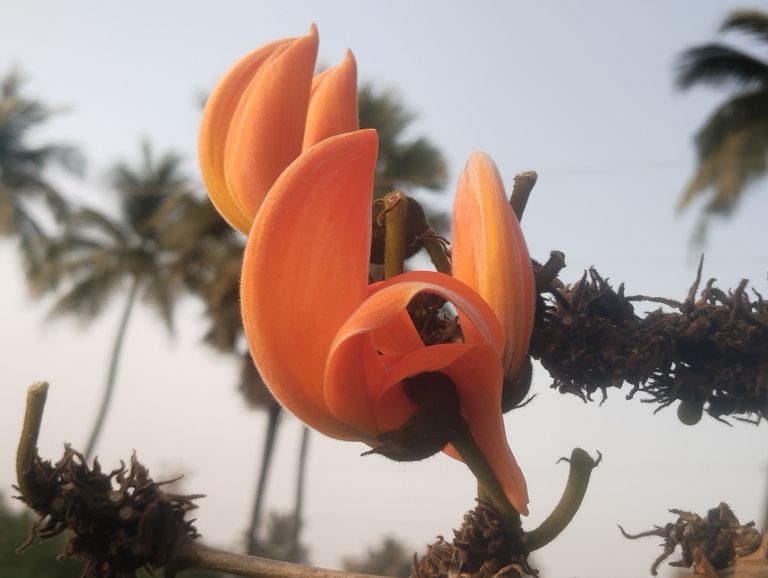
The Beauty of Palash Flowers A Fiery Bloom of Nature.
Nature is a magnificent artist, painting landscapes with vibrant colors and enchanting aromas. Among its many wonders, the Palash flower (Butea monosperma), also known as the Flame of the Forest, stands out as a true spectacle of beauty. Its fiery orange-red petals create a breathtaking view, signaling the arrival of spring in South Asian countries like India, Bangladesh, Nepal, and Pakistan. This blog explores the beauty, symbolism, cultural significance, and ecological importance of the Palash flower, a gem of tropical and subtropical landscapes.
The Stunning Appearance of Palash Flowers
The Palash tree is a deciduous species that sheds its leaves in winter, preparing for a mesmerizing floral display in spring. When in full bloom, the tree is covered in clusters of bright orange, red, or yellow flowers, creating an illusion of flames dancing on the branches. The flowers have a unique curved petal structure, resembling a parrot’s beak, which adds to their exotic charm.
Palash flowers are admired for their:
Vibrant hues: The fiery red and orange shades symbolize passion, vitality, and energy.
Unique shape: The petals are curved and velvety, arranged in clusters.
Contrast with bare branches: The leafless tree creates a striking visual impact, making the flowers even more prominent.
Cultural and Historical Significance of Palash Flowers
Palash flowers have deep cultural and historical importance, especially in South Asia. They have been mentioned in ancient scriptures, poetry, and folklore.
- Symbol of Spring and Festivals
In India and Bangladesh, Palash flowers are synonymous with spring. Their bloom coincides with Holi, the festival of colors, and Basant Panchami, marking the arrival of warmer days. People use Palash flowers to prepare natural dyes for Holi celebrations.
- Spiritual and Religious Importance
Hindu mythology associates the Palash tree with Lord Shiva and Goddess Saraswati. The tree is considered sacred and is often used in religious rituals. In Buddhism, Palash is regarded as an auspicious plant, symbolizing purity and enlightenment.
- A Muse for Poets and Artists
Poets and artists have long admired the flaming beauty of Palash. In Bengali literature, it is often referenced as a symbol of love, separation, and longing. Rabindranath Tagore, the Nobel laureate poet, mentioned Palash in his writings, celebrating its poetic charm.
Ecological Importance of Palash Trees
Beyond their visual appeal, Palash flowers and trees play a crucial role in maintaining ecological balance.
- A Haven for Pollinators
Palash flowers are rich in nectar, attracting bees, butterflies, and birds like sunbirds and mynas. These pollinators help in maintaining biodiversity.
- Soil Enrichment
Palash trees have nitrogen-fixing properties, improving soil fertility. Their fallen leaves decompose and enhance organic matter in the soil.
- Shelter for Wildlife
The tree provides shelter and nesting sites for birds, small mammals, and insects, contributing to the forest ecosystem.
Traditional and Medicinal Uses of Palash Flowers
Palash is not just admired for its beauty; it has been valued in traditional medicine and folk remedies for centuries.
- Herbal Healing
In Ayurveda and Unani medicine, Palash flowers, leaves, and seeds are used for their anti-inflammatory, antibacterial, and antioxidant properties. They are believed to treat:
Skin disorders
Digestive issues
Respiratory problems
- Natural Dye and Cosmetics
The bright orange pigment from Palash flowers is used to make natural dyes for textiles, cosmetics, and Holi colors.
- Wood and Resin Benefits
Palash wood is used for making agricultural tools, while the tree's gum, known as Bengal Kino, is used in traditional medicine and dye production.
Conservation and Protection of Palash Trees
Despite their cultural and ecological significance, Palash trees face threats from deforestation, urbanization, and climate change. Conservation efforts must be made to:
Plant more Palash trees in urban and rural areas.
Protect existing forests and natural habitats.
Promote awareness about the importance of indigenous flowering trees.
Conclusion
The Palash flower, with its fiery brilliance, is more than just a seasonal bloom; it is a symbol of passion, vitality, and cultural heritage. From its aesthetic appeal to its ecological benefits and medicinal uses, the Palash tree is a true gift of nature. As spring arrives and the forests light up with its dazzling flames, let us appreciate and protect this spectacular tree for generations to come.
Have you ever seen a Palash tree in full bloom? Share your experience in the comments.
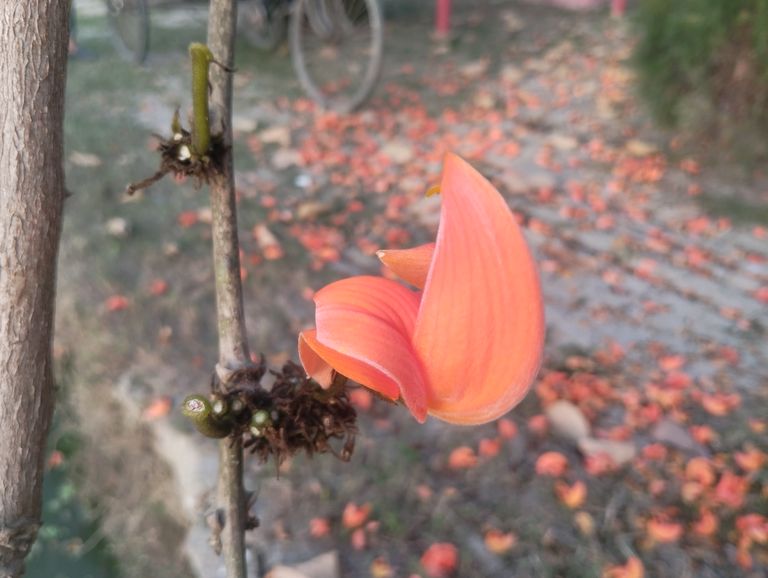
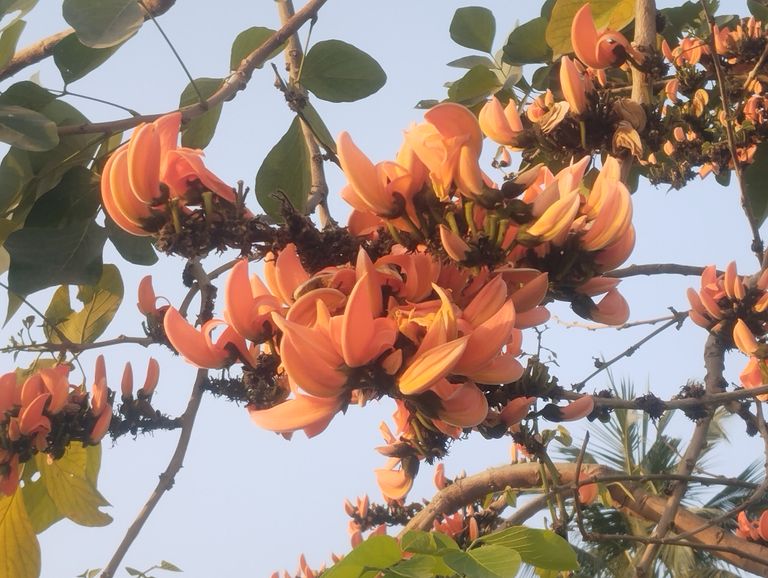
The Season of Blooming Palash Flowers: A Fiery Symphony of Spring
The arrival of spring in South Asia is marked by the blooming of the magnificent Palash flower (Butea monosperma), often called the "Flame of the Forest." With its fiery red and orange petals, this vibrant blossom transforms the landscape into a breathtaking spectacle. As the winter chill fades away and nature awakens, Palash flowers paint the countryside in hues of fire, symbolizing renewal, passion, and festivity.
The Beauty and Significance of Palash Flowers
Palash is more than just a flower; it holds deep cultural, religious, and ecological significance. Its bright, flame-like petals captivate the hearts of nature lovers, poets, and artists. The tree, often leafless during the blooming season, stands like a burning torch against the clear blue sky, making it one of the most iconic sights of spring.
In India, Bangladesh, and Nepal, the Palash flower is associated with love, strength, and resilience. It is often linked to Holi, the festival of colors, as its natural dye has been used for centuries to prepare organic colors. In some regions, it is also known as Tesu, Dhak, or Flame of the Jungle.
When and Where Does Palash Bloom?
Palash flowers typically bloom between February and April, depending on the climate and region. These blossoms thrive in tropical and subtropical regions, covering parts of India, Bangladesh, Nepal, Sri Lanka, and Thailand.
Palash trees are commonly found in dry deciduous forests, rural fields, and roadside landscapes. Some of the best places to witness their blooming splendor include:
Shantiniketan, West Bengal, India – Known for its connection with Rabindranath Tagore, this town becomes a paradise of Palash flowers during spring.
Chhota Nagpur Plateau, Jharkhand, India – This region’s forests burst into flames of red with blooming Palash.
Madhya Pradesh, India – The state's forests and national parks showcase stunning Palash landscapes.
Sylhet and Chittagong Hill Tracts, Bangladesh – The rolling hills and valleys come alive with these fiery blossoms.
Palash in Folklore, Literature, and Art
Palash flowers have inspired countless poets, artists, and writers. Rabindranath Tagore, the legendary Bengali poet, often mentioned Palash in his poems and songs. His love for nature, especially the red blossoms of spring, is reflected in his works.
In Hindu mythology, Palash is associated with Lord Shiva and Goddess Saraswati. Some believe it is a sacred tree with divine energy. The leaves of the Palash tree are traditionally used in Hindu rituals and ceremonies.
The flower is also widely referenced in folk songs, proverbs, and regional literature, symbolizing passion, separation, and the beauty of nature.
Ecological Importance of Palash Trees
Beyond their aesthetic charm, Palash trees play a vital role in the ecosystem. They:
Support Biodiversity – The nectar-rich flowers attract bees, butterflies, and birds, making them an important part of pollination.
Improve Soil Health – Palash trees are nitrogen-fixing, enriching the soil and promoting vegetation growth.
Drought Resistance – These trees are highly resilient to dry conditions, making them suitable for arid and semi-arid regions.
The tree's bark, gum, and flowers also have medicinal properties. In Ayurveda, Palash is used to treat skin diseases, digestive disorders, and infections.
Palash and Festivals
The blooming of Palash marks the arrival of spring festivals across South Asia. One of the most famous festivals linked to this flower is Holi, celebrated with joy and colors. Traditionally, the petals of Palash were used to make natural Holi colors.
In West Bengal, the Basanta Utsav (Spring Festival) at Shantiniketan, initiated by Rabindranath Tagore, celebrates the beauty of spring with music, dance, and colors inspired by the blooming Palash.
Conservation and Threats
Despite its cultural and ecological significance, Palash trees face threats due to deforestation, urbanization, and habitat loss. Large-scale land clearing for agriculture and construction has reduced their numbers. To preserve this natural treasure, efforts should be made to:
Plant more Palash trees in urban and rural areas.
Promote awareness of their ecological and cultural importance.
Use organic and natural dyes instead of chemical colors during Holi and other celebrations.
Conclusion
The blooming of Palash flowers is a magnificent celebration of nature’s fiery beauty. As these blossoms set the forests and countryside ablaze with red and orange hues, they remind us of the vibrancy of spring and the cycle of renewal. Whether admired in poetry, worshipped in rituals, or cherished in festivals, Palash continues to inspire and captivate generations.
As we welcome another season of Palash flowers, let us appreciate their beauty, respect their significance, and take steps to ensure that future generations can witness their breathtaking bloom.
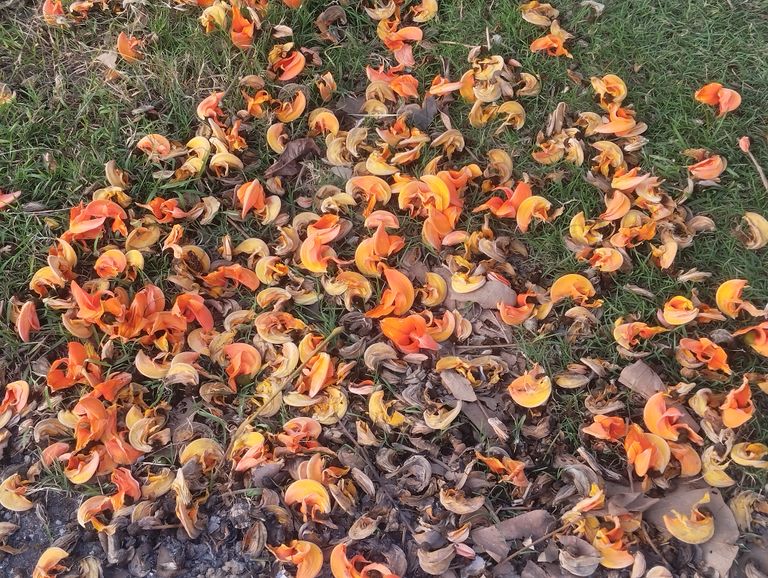
Medicinal Benefits of the Palash Flower
The Palash flower (Butea monosperma), also known as the "Flame of the Forest," is a vibrant orange-red bloom native to South Asia. It has been revered for centuries in Ayurveda, Unani, and folk medicine for its numerous therapeutic properties. This article explores the medicinal benefits of the Palash flower, its uses, and how it contributes to holistic well-being.
Introduction to Palash Flower
Palash is a deciduous tree found in India, Bangladesh, Nepal, and Sri Lanka. It typically blooms during spring (February to April), covering landscapes with its fiery blossoms. Beyond its ornamental beauty, the Palash flower is packed with medicinal compounds that make it a valuable herb in traditional medicine.
Medicinal Properties of Palash Flower
Palash flowers contain flavonoids, tannins, alkaloids, glycosides, and essential oils, making them beneficial for various ailments. They have the following properties:
Anti-inflammatory – Helps reduce swelling and pain.
Antibacterial & Antifungal – Fights infections.
Diuretic – Aids in detoxification.
Astringent – Helps in wound healing.
Antioxidant – Protects cells from damage.
Aphrodisiac – Enhances sexual health.
Health Benefits of Palash Flower
- Treats Skin Disorders
Palash flowers have powerful antimicrobial and anti-inflammatory properties, making them effective in treating eczema, acne, rashes, and skin infections. A paste made from the petals can be applied to wounds and ulcers to promote healing.
- Improves Digestive Health
Palash flowers are beneficial for the digestive system. They help in treating diarrhea, dysentery, and irritable bowel syndrome (IBS) by balancing gut bacteria and reducing inflammation. Palash flower extracts also aid in relieving constipation.
- Supports Kidney and Liver Health
The diuretic properties of Palash help in flushing out toxins from the body, supporting kidney health. It also protects the liver from damage caused by free radicals and toxins, making it useful in treating jaundice and liver disorders.
- Aids in Diabetes Management
Studies suggest that Palash flower extracts help regulate blood sugar levels, making them beneficial for diabetic patients. The antioxidants in the flower prevent oxidative stress, which is a key factor in diabetes complications.
- Enhances Reproductive Health
Palash flowers have been traditionally used to improve sexual health. They help in treating infertility and menstrual disorders in women. In men, they act as an aphrodisiac and boost libido.
- Boosts Immunity
Rich in antioxidants and bioactive compounds, Palash helps strengthen the immune system, making the body more resistant to infections and diseases.
- Alleviates Respiratory Issues
Palash flower decoctions are often used to treat cough, asthma, and bronchitis. They help clear mucus from the respiratory tract and provide relief from congestion.
- Promotes Hair Health
Palash flowers are beneficial for hair care. They help in reducing dandruff, preventing hair fall, and promoting hair growth when used in herbal shampoos or hair masks.
How to Use Palash Flower Medicinally
- Palash Flower Tea
Ingredients: Dried Palash flowers, hot water, honey (optional)
Preparation: Steep 1-2 teaspoons of dried flowers in hot water for 10 minutes, strain, and drink. This tea helps detoxify the body and improve digestion.
- Palash Flower Paste for Skin & Hair
For Skin: Mix Palash flower powder with turmeric and honey, apply to affected areas, leave for 20 minutes, and rinse off.
For Hair: Mix Palash flower powder with coconut oil and apply as a hair mask to promote hair growth and reduce dandruff.
- Palash Flower Decoction for Respiratory Health
Boil fresh or dried Palash flowers in water and drink it warm to relieve cough and asthma symptoms.
- Palash Powder for Digestive Issues
Dried Palash flowers can be ground into powder and consumed with warm water or honey to treat digestive disorders.
Precautions and Side Effects
While Palash flowers are generally safe for use, excessive consumption may cause nausea or stomach irritation. Pregnant and breastfeeding women should consult a doctor before using Palash-based remedies.
Conclusion
The Palash flower is not only a symbol of beauty but also a powerhouse of medicinal properties. Its benefits range from improving digestion and immunity to enhancing skin, hair, and reproductive health. With its rich history in traditional medicine, Palash continues to be a natural remedy for various ailments, promoting holistic well-being.
By incorporating Palash flowers into your daily routine, you can harness their therapeutic potential and lead a healthier life.
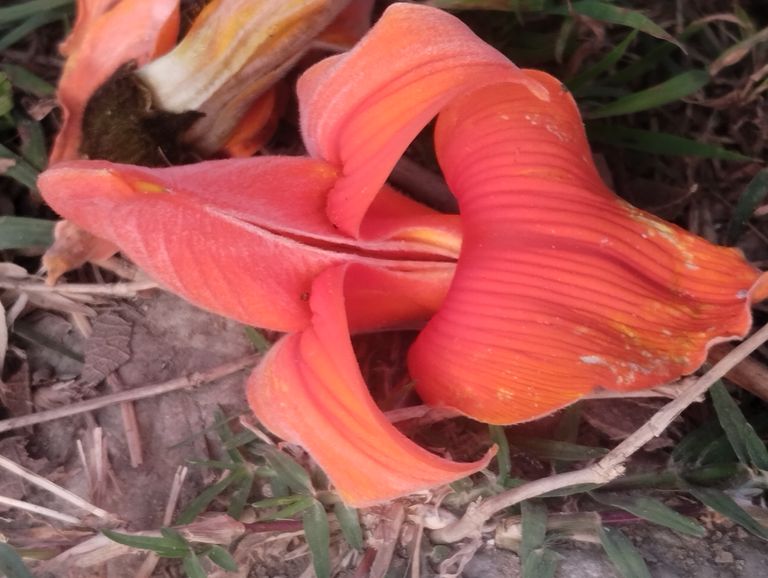
Medicinal Benefits of the Palash Flower
The Palash flower (Butea monosperma), also known as the "Flame of the Forest," is a vibrant orange-red bloom native to South Asia. It has been revered for centuries in Ayurveda, Unani, and folk medicine for its numerous therapeutic properties. This article explores the medicinal benefits of the Palash flower, its uses, and how it contributes to holistic well-being.
Introduction to Palash Flower
Palash is a deciduous tree found in India, Bangladesh, Nepal, and Sri Lanka. It typically blooms during spring (February to April), covering landscapes with its fiery blossoms. Beyond its ornamental beauty, the Palash flower is packed with medicinal compounds that make it a valuable herb in traditional medicine.
Medicinal Properties of Palash Flower
Palash flowers contain flavonoids, tannins, alkaloids, glycosides, and essential oils, making them beneficial for various ailments. They have the following properties:
Anti-inflammatory – Helps reduce swelling and pain.
Antibacterial & Antifungal – Fights infections.
Diuretic – Aids in detoxification.
Astringent – Helps in wound healing.
Antioxidant – Protects cells from damage.
Aphrodisiac – Enhances sexual health.
Health Benefits of Palash Flower
- Treats Skin Disorders
Palash flowers have powerful antimicrobial and anti-inflammatory properties, making them effective in treating eczema, acne, rashes, and skin infections. A paste made from the petals can be applied to wounds and ulcers to promote healing.
- Improves Digestive Health
Palash flowers are beneficial for the digestive system. They help in treating diarrhea, dysentery, and irritable bowel syndrome (IBS) by balancing gut bacteria and reducing inflammation. Palash flower extracts also aid in relieving constipation.
- Supports Kidney and Liver Health
The diuretic properties of Palash help in flushing out toxins from the body, supporting kidney health. It also protects the liver from damage caused by free radicals and toxins, making it useful in treating jaundice and liver disorders.
- Aids in Diabetes Management
Studies suggest that Palash flower extracts help regulate blood sugar levels, making them beneficial for diabetic patients. The antioxidants in the flower prevent oxidative stress, which is a key factor in diabetes complications.
- Enhances Reproductive Health
Palash flowers have been traditionally used to improve sexual health. They help in treating infertility and menstrual disorders in women. In men, they act as an aphrodisiac and boost libido.
- Boosts Immunity
Rich in antioxidants and bioactive compounds, Palash helps strengthen the immune system, making the body more resistant to infections and diseases.
- Alleviates Respiratory Issues
Palash flower decoctions are often used to treat cough, asthma, and bronchitis. They help clear mucus from the respiratory tract and provide relief from congestion.
- Promotes Hair Health
Palash flowers are beneficial for hair care. They help in reducing dandruff, preventing hair fall, and promoting hair growth when used in herbal shampoos or hair masks.
How to Use Palash Flower Medicinally
- Palash Flower Tea
Ingredients: Dried Palash flowers, hot water, honey (optional)
Preparation: Steep 1-2 teaspoons of dried flowers in hot water for 10 minutes, strain, and drink. This tea helps detoxify the body and improve digestion.
- Palash Flower Paste for Skin & Hair
For Skin: Mix Palash flower powder with turmeric and honey, apply to affected areas, leave for 20 minutes, and rinse off.
Congratulations, your post has been upvoted by @dsc-r2cornell, which is the curating account for @R2cornell's Discord Community.
Enhorabuena, su "post" ha sido "up-voted" por @dsc-r2cornell, que es la "cuenta curating" de la Comunidad de la Discordia de @R2cornell.